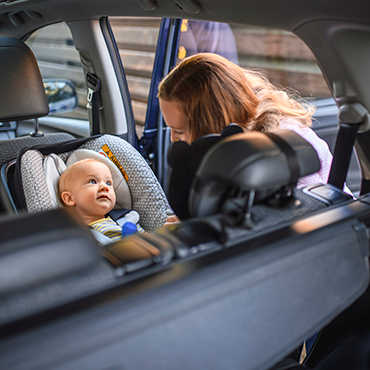
Make sure you are aware of Washington state car seat laws that help keep our children safe. The first step in car seat safety is learning how to properly install a car seat in your car. Several locations in the area offer car seat checks. Car seats should be installed in the back, and ideally in the middle seat. Make sure that children are buckled up in the correct type of seat on every trip. It’s also important to be a role model for your children, so make sure you buckle up every time, too.
How to choose a car seat:
Infants and toddlers should ride in a rear-facing car seat until they reach the height or weight limit allowed by the manufacturer. Once they graduate from the rear-facing infant seat, they can use a convertible car seat, rear-facing. Under the new law, children under 2 years old must remain rear-facing until they reach the manufacturer’s height or weight restrictions.
Preschoolers who have outgrown their rear-facing seat should ride in a forward-facing car seat. Children ages 2-4 should remain in a forward-facing car seat until they reach the manufacturer’s height and weight restrictions. Children over the age of 4, but shorter than 4 feet 9 inches who outgrow their forward-facing car seat are required to use a booster seat.
School-aged children should ride in a booster seat until they are 4 feet 9 inches. For most children, this can be somewhere between age 10 and 12. Please ensure that the lap and shoulder belts fit properly.
Children under the age of 13 should not ride in the front seat, regardless of their height.
Some common questions:
My infant prefers to face forward in the car and her feet are squished against the back of the seat. Can I turn her earlier? The rear-facing position best protects the head and spinal cord from injury. Therefore, infants should stay rear-facing as long as possible.
Can I put a child in a car seat with their winter coat? Thick clothing keeps you from tightening the harness straps enough to prevent injury. Instead, put a blanket or coat over the buckled harness straps.
How do I know my child is ready to graduate from a booster seat? There are several steps to check to see if the seatbelt fits properly. The shoulder belt should go across the chest and shoulder, and not across the neck. The lap belt should lie across the upper thighs, so it does not compress the abdomen. Finally, the child should be able to sit against the back of the seat with their knees bent over the edge of the seat.
Where do I find a car seat inspection location near me?
- Seattle Children’s Hospital
- Evergreen Hospital
- Overlake Hospital
- The Safety Restraint Coalition – 800bucklup
Dr. Irene Tham is a pediatrician in the Allegro Pediatrics Sammamish location.
Keep Reading
View All Posts
Summer Safety Tips
Summer is a season of fun and adventure, but it also brings unique safety challenges for kids. Dr. Brianna Label offers practical tips to help families stay safe all season long.

Nexplanon: A Guide for Teens and Parents
Nexplanon is a form of Long-Acting Reversible Contraception (LARC) offered at Allegro for birth control or to help manage painful periods. Learn how it works, its benefits, and potential side effects to help you and your teen make informed decisions together.


